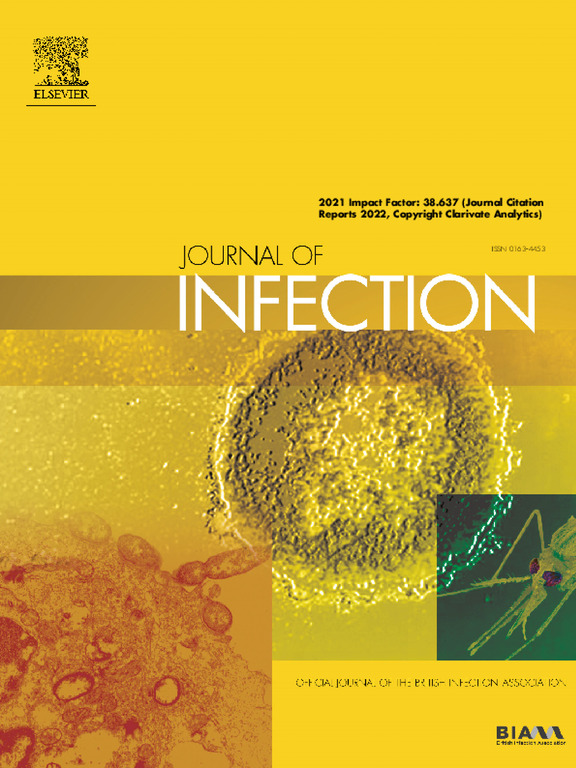英国成人青霉素和其他抗生素过敏的特点、危险因素和临床影响:一项基于人群的队列研究
IF 14.3
1区 医学
Q1 INFECTIOUS DISEASES
引用次数: 0
摘要
目的:了解青霉素及其他抗生素过敏标签在英国的特点、危险因素及临床影响。设计:基于人群的队列研究。背景:2000-2018年英国初级保健。参与者:年龄在18-100岁之间的成年人,他们在2000年1月1日至2018年12月31日期间在全科诊所注册了至少12个月,并随访至2019年9月25日。主要结局指标:主要结局指标包括青霉素和其他抗生素过敏标签的年患病率和发病率。使用多项逻辑回归来检查与接受不同抗生素过敏标签相关的特征。采用Cox回归模型比较有和没有过敏标签的患者之间耐药感染(耐甲氧西林金黄色葡萄球菌[MRSA]和耐万古霉素肠球菌)以及艰难梭菌(C.difficile)感染的风险。计算2014年9月记录过敏标签前或一年内每月进行青霉素过敏试验的患者比例,以评估NICE青霉素过敏评估建议(临床指南[CG183])的影响。结果:青霉素过敏标签的流行率和发生率均呈先上升后下降的趋势。2011年患病率最高,为8.25%,2004年发病率最高,为0.46%。年龄较大、女性、生活在较贫困地区、属于较大的全科诊所以及有合并症与接受青霉素或其他抗生素过敏标签的可能性较高相关。有抗生素过敏标签的患者更有可能接受替代广谱抗生素,并且MRSA和艰难梭菌感染的风险更高。NICE药物过敏指南的引入并未改变接受青霉素过敏评估的患者比例。结论:青霉素和其他抗生素过敏标签是常见的,导致抗生素处方实践的根本改变,并与耐药和卫生保健相关感染有关。本文章由计算机程序翻译,如有差异,请以英文原文为准。
Characteristics, risk factors and clinical impact of penicillin and other antibiotic allergies in adults in the UK General Practice: A population-based cohort study
Objective
To assess the characteristics, risk factors and clinical impact of penicillin and other antibiotic allergy labels in general practice in the UK.
Design
Population-based cohort study.
Setting
Primary care in the UK, 2000–2018.
Participants
Adults aged 18–100 years who were registered with their general practice for at least 12 months between 01-Jan-2000 and 31-Dec-2018 and followed until 25-Sep-2019.
Main outcome measures
The main outcomes include the annual prevalence and incidence of penicillin and other antibiotic allergy labels. Multinominal logistic regression was used to examine the characteristics associated with receiving an allergy label to different antibiotics. Cox regression modelling was used to compare the risk of resistant infections (methicillin-resistant Staphylococcus aureus [MRSA] and vancomycin-resistant enterococci) as well as Clostridioides difficile (C.difficile) infection between patients with and without allergy labels. The monthly proportion of patients who had a penicillin allergy test, either before their allergy label was recorded or within one year, was calculated to assess any impact of NICE penicillin allergy assessment recommendations (Clinical guideline [CG183]) in September 2014.
Results
Both the prevalence and incidence of penicillin allergy label showed a pattern of initial growth followed by a decline. The prevalence reached a maximum of 8.25% in 2011, and the incidence peaked at 0.46% in 2004. Older age, being female, living in less deprived areas, belonging to a larger general practice, and having co-morbidities were associated with a higher chance of receiving a penicillin or other antibiotic allergy label. Patients with antibiotic allergy labels were more likely to receive alternative broad-spectrum antibiotics and had a higher risk of MRSA and C.difficile infections. The introduction of NICE drug allergy guideline did not alter the proportion of patients undergoing penicillin allergy assessment.
Conclusion
Penicillin and other antibiotic allergy labels are common and lead to radical change in the antibiotic prescribing practices and are associated with resistant and healthcare associated infections.
求助全文
通过发布文献求助,成功后即可免费获取论文全文。
去求助
来源期刊

Journal of Infection
医学-传染病学
CiteScore
45.90
自引率
3.20%
发文量
475
审稿时长
16 days
期刊介绍:
The Journal of Infection publishes original papers on all aspects of infection - clinical, microbiological and epidemiological. The Journal seeks to bring together knowledge from all specialties involved in infection research and clinical practice, and present the best work in the ever-changing field of infection.
Each issue brings you Editorials that describe current or controversial topics of interest, high quality Reviews to keep you in touch with the latest developments in specific fields of interest, an Epidemiology section reporting studies in the hospital and the general community, and a lively correspondence section.
 求助内容:
求助内容: 应助结果提醒方式:
应助结果提醒方式:


